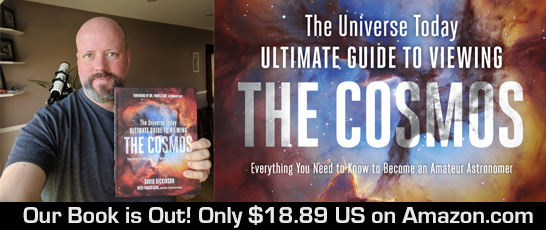How to survive when the Sun gets too hot for life on Earth
As you probably know, the Sun is slowly heating up. Not enough to explain global warming, but over the next few hundred million to a billion years or so, temperatures are going to get so hot that the oceans will boil and life on the surface of Earth will go extinct.
Even though this isn't going to happen for a long long time, people wonder what we could do about it. How could we save the Earth? Professor Abraham Loeb from Harvard gets this question a lot, and in an article for Scientific American, he proposes various methods we could use to relocate the Earth farther out in the Solar System as the energy from the Sun gradually increases.
It's silly speculation, of course, there's no reason to think humanity will last long enough for this to be a problem, but still, it's fun to think about.
Thanks!
Fraser Cain
Publisher
Universe Today
As always, if you have comments or questions, or suggestions on how I can improve this newsletter, please don't hesitate to reply this email or email me at info@universetoday.com.
Patrons, don't forget to log in to Universe Today. That'll remove all the ads for you. Join the 843 Patrons who get our videos early, see behind the scenes, and get no ads on Universe Today.
Q&A 107: All Your James Webb Questions, Answered
In this week's questions show, I tackle all the questions about James Webb generated by the videos we did this week. Can it be refueled? How can it see the entire sky? Is the delay a blessing? And more...
Subscribe to our podcasts:
Universe Today Guide to Space Audio: iTunes - RSS
Audio versions of all the media I upload to my YouTube channel, as well as bonus content, behind the scenes, interviews with Fraser and more
Astronomy Cast: iTunes - RSS
Your weekly facts-based journey through the cosmos, which I co-host with astronomer Dr. Pamela Gay. We have episodes on every concept in space and astronomy, from black holes to the history of astronomy.
Weekly Space Hangout: iTunes - RSS
A weekly round-up of all the breaking space news. Rocket launches, new discoveries from Hubble, and planetary science by a round table of scientists and space journalists.
Hubble Observes the Most Powerful Gamma Ray Burst Ever Detected
Gamma-ray bursts are some of the most powerful explosions in the Universe, generated when massive stars go supernova. And now astronomers have confirmed that one of these bursts found back in January 2019, was the most powerful one ever recorded, clearly visible in telescopes, even though the galaxy was 5 billion light-years away.
Aquatic Rover Drives on the Underside of the Ice in Antarctica
We imagine rovers as friendly robots like Spirit and Opportunity rolling across the surface of Mars. But NASA is testing out new strategies for exploring alien worlds. They recently tried out a buoyant rolling vehicle designed to explore the underside of ice sheets in Antarctica. Can you imagine something like this being used in Europa or Enceladus in the far future?
Of the Two Stars in Alpha Centauri, One is Probably More Habitable than the Other
When we think about the search for habitable planets out there in the Milky Way, we consider the conditions of the planets themselves, if there's liquid water, etc. But the stars themselves could also define the habitability of any planets in the system. Astronomers recently studied the characteristics of the near-twin binary stars that comprise Alpha Centauri and suggested that one is actually more habitable than the other.
New Satellites Will Tell Us Exactly how Quickly the Oceans are Rising
Thanks to global warming, we know that the Earth's oceans are rising year by year, both from melted ice and the expansion of water as it gets warmer. The US and Europe are planning to launch a pair of identical satellites called Sentinel-6A and 6B which will measure ocean levels with unprecedented precision, to give scientists a better understanding of global sea-level rise.
Using Bacteria to Build a Base on Mars
If we want to live on Mars, we're going to need to learn to live off the land, building homes and everything in them from raw materials found on Mars. But we might have some help in the form of bacteria that consumes Martian regolith and leaves behind raw metal. Researchers are proposing we send a bioreactor containing these bacteria, to generate raw materials before human settlers actually arrive.
Astronomers Find a Galaxy Containing Three Supermassive Black Holes at the Center
Astronomers know that there's a supermassive black hole at the heart of almost every galaxy in the Universe, but now they've found one that actually has three. The galaxy is called NGC 6240 and it's located 400 million light-years from Earth. A recent study found that it's the result of three galaxies colliding together, each of which supplied a supermassive black hole. This could help explain how some galaxies got so big so quickly.
Here's a Deepfake of Nixon Giving a Eulogy for the Apollo 11 Astronauts if Their Mission Failed
Apollo 11 was a success, and the three astronauts returned safely home to Earth. But if there a problem, US President Nixon was ready to read a very sad statement about the potentially doomed astronauts. MIT's Center for Advanced Virtuality took this premise and created a "deep fake" of President Nixon, including his voice, as he reads out the statement. I'm glad this is only a simulation, and it never happened for real.
There Could be Planets Orbiting Around Supermassive Black Holes
It's hard to imagine a more inhospitable place than the region around a supermassive black hole with millions or even billions of times the mass of the Sun. But astronomers have simulated the environment and are proposing that planets could actually form in a black hole's accretion disk and remain in orbit around a black hole. But you still wouldn't want to live there.
A Fifth Fundamental Force Could Really Exist, But We Haven't Found It Yet
There are four basic forces in the Universe, but it's incomplete and doesn't explain some of the mysteries of the Universe like dark matter. Physicists are starting to suspect there might be a fifth fundamental force, which would interact with particles in subtle ways that create these large scale structures we can detect. A new paper suggests a form that fifth force could take, but the evidence is very weak so far.
Finally! Scientists Find a Place on Earth with Liquid Water But No Life
You've probably heard me say it many times. Wherever we find water on Earth, we find life. At the bottom of the ocean, under glaciers, high up in the atmosphere, deep inside the Earth. Well, not so fast. Researchers have finally found a spot that has water, but it's so terrible, no life at all has managed to survive there.
No, Jupiter's Great Red Spot is not Disintegrating, Physicist Claims
Over the hundreds of years astronomers have been observing Jupiter, it's mighty Red Spot seems to be shrinking in size. In fact, it's predicted that this cyclonic storm might disappear completely in a few decades. But now a physicist has proposed that it just looks like it's disintegrating, with red flakes tearing away, but other material replenishing it as well.
NASA Supercomputer Simulates the Weather on Mars
How's the weather on Mars? Really really cold, obviously, but a new team from NASA has developed a supercomputer simulation to see how water vapor, carbon dioxide, and dust interact to create the planet's climate. One goal of this research is to study the planet's water cycle, how it changed over billions of years as the planet got drier and drier.
When Martian Storms Really Get Going, they Create Towers of Dust 80 Kilometers High
Back in 2018, a global dust storm on Mars was so powerful it took out NASA's Opportunity rover. In fact, when these storms really get rolling on Mars, they can create towers of dust 80 km high. They start out as a small region of rapidly rising dust which grows and grows to incredible heights. This dust then forms a layer as big as the continental US. This process might help planetary scientists understand how Mars lost its water.
Astronomers Are About to Detect the Light from the Very First Stars in the Universe
Just a few million years after the Big Bang, the primordial hydrogen and helium came together to form the first stars in the Universe. Without any heavier elements in them, they're incredibly large and massive, detonating as supernovae in a very short period of time. Astronomers have a new instrument in Australia called the Murchison Widefield Array which might let them finally detect the signal from these first stars.
Other Interesting Space Stuff
- What can artificial intelligence do for physics? And what will it do to physics?
- Meteor Shower A Dud, But Showing Up Was Half The Fun
- How Borisov found Borisov (the second interstellar object)
- Using balloons to launch rockets
- One more launch makes Starlink the biggest constellation
- A Detailed Look At China's Space Ambitions
- Virgin Galactic rides out early struggles on Wall Street
- Chinese bolster navigation system with dual Beidou launch
- Hobby Killers: What Telescopes Not to Buy
- The Ariane 6 is coming together
- Weekly Space Hangout: November 27, 2019 - Dylan O'Donnell, Director of DNA Digital and zen10 Australia
- A spent booster just smashed a building China
- Antarctic Ice Cores Offer a Whiff of Earth's Ancient Atmosphere
- How do neutron stars and black holes shine so brightly?
- Researchers have counted up 77 impact craters on asteroid Ryugu, revealing the history of its formation
- Cancer seems to have trouble spreading in microgravity
- There's now an operational radio telescope on the far side of the Moon
- Europe commits to a space budget of $15.84 billion, their biggest ever
- Different types of stars will have terrestrial planets with different climates
- Giant meteor impacts might have triggered early Earth's plate tectonics
- Domes are very over-rated
Amazing Astrophotography on @universetoday
Tarantula Nebula
My favorite pictures shared on our Instagram account this week is this stunning picture of the Tarantula Nebula. This is an enormous star-forming region that's only visible from the southern hemisphere. This picture was shared by @deepskywest from their new observatory in the Atacama Desert.
We have featured thousands of astrophotographers on our Instagram page, which has more than 191,000 followers. Want to do a takeover? Use the hashtag #universetoday and I'll check out your photos.
Find your way across the night sky. Choose a variety of astronomy gear. Follow the Moon and the planets. Find deep sky objects across the seasons in both hemispheres. Observe comets, asteroids, satellites and space stations. Learn to do astrophotography.
Get it on Amazon for only $18.89. Here are some other options.
|


